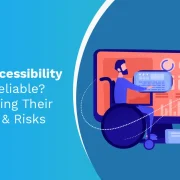
eLearning Localization – The Next Big Trend in Employee Training
With technology making the world a more close-knit community and a large number of companies acquiring a global footprint, eLearning localization has become a pressing need to maintain the effectiveness of training programs.
Thankfully, eLearning has come a long way since its early days where printed versions of educational or training materials were simply digitized to make them accessible on different devices.
Back then, transforming lengthy, word-heavy content into an engaging or interactive format seemed improbable, let alone localizing it for audiences in different parts of the world. However, today there are a host of tools available that make this process relatively simple and straightforward.
Here is everything you need to know about localizing eLearning modules and its benefits for training programs:
What is eLearning Localization and Translation?
Today, employee training programs aren’t necessarily restricted to a small cluster of participants in one place. The employees you’d like to extend the benefits of upskilling to may be based out of different cities across the world. That’s where eLearning localization plays a crucial role. It adapts the content of any training program as per the specific local culture of any region.
Essentially, this is an improvement on the process of translation. While in translation, the content is merely converted from one language to another, localization also takes into account the cultural reference of a place and adapts the entire training material – not just text – accordingly.
The localization of content extends to Graphical User Interface, tone of narration, fonts, colors, symbols, photos, images, measurement units, idioms, phrases and abbreviations, to name a few.
The idea here is to convey the exact message as the source content, with the right context, setting and emotion.
Who Needs to Localize eLearning?
If your training program is targeted at learners from different parts of the world, it is crucial to go beyond translation and localize the content. Colors, imagery, background, tone of narration and gestures can mean different things in different places. For instance, the Western audience is more used to their teachers/instructors maintaining a friendly tone, while in the East, learning is associated with an authoritative tone.
Translation cannot address these finer nuances. If the content is not in line with a learner’s cultural appropriation, it can be hard to relate to. Localizing the training material can, therefore, help improve acquisition and retention of new skills and knowledge.
Benefits of eLearning localization Implementing eLearning localization can be a win-win for a company and the employees, as it promises optimal targeted opportunities for acquiring new skills and knowledge.
Here are the top benefits of going beyond translations and localizing employee training programs:
1. Diversity in Training Modules
Localizing online training modules allows organizations to create one elaborate program and then optimize it to suit the needs of employees in different geographical locations, instead of creating separate ones for different locations.
The eLearning localization tools can use the basic information and structure of the source module and adapt the message as per the sensibilities of the target audience.
2. Broader Reach with Minimal Resources
Localizing a base or source training module for participants in different locations can ensure a broader reach for the program in a more cost-effective manner. The resources needed to optimize an existing training module are far lower in comparison to developing different modules from scratch.
To make sure that the optimization process is as resource efficient as possible, it is advisable to use simple language in the source module and eliminate the use of complex jargon, graphs and images embedded with text. A clean structure and design are what effective localization rests on.
3. Uniformity
The fact that you are leveraging the same source module to train employees in different locations brings in an element of uniformity in your training initiatives. With the same written and multimedia content being made available to all participants, albeit, in different languages and cultural contexts, you can ensure that your employees in the US and in Asia or Europe are being empowered with the same skill set and knowledge.
4. Higher ROI
High Returns on Investment is the basic goal that drives most business decisions and localizing the training module accords you an opportunity to optimize that. Hiring training experts for different office locations across the world can be a capital-intensive process.
By comparison, working with a team of experts to localize high-quality content and deliver it as an online training program can save time, money and effort.
5. Better Impact
Localizing the content lends a personalized touch while dealing with employee needs and makes your workforce feel valued, irrespective of their location. A strong, committed workforce is the backbone that can help an organization gain a competitive edge in the global markets.
Employees are more likely to engage with the training material, retain it better, and subsequently, apply it in their work processes – which is the main objective behind training programs.
6. Helps Boost the Brand Image
Investing in eLearning localization for employee training can also serve as a catalyst for boosting your brand image. Being mindful of the cultural values and difference of your workforce and accommodating these factors in your internal processes positions you as a truly inclusive organization that values diversity.
This wins not only the loyalty of your workforce but also the respect of stakeholders, which can go a long way in bolstering growth.Necessity, Not Luxury Learning in one’s native language surely helps people understand the content better, but with eLearning localization, they can be empowered toward more holistic knowledge acquisition and retention.
Any company that aims to use employee training modules as a means to transform its operations needs to pay attention to this approach.
Related:
- 7 Tips to Create Custom E-Learning Content on a Budget
- Custom LMS- An Effective Way to Transform Employee Training
- 10 Reasons to Invest in Corporate Training Solutions
- How to Implement Microlearning in Corporate Training
- How to Leverage your LMS to Create a Blended Learning Environment
- Advantages of Mobile Learning Solutions for L&D Teams








